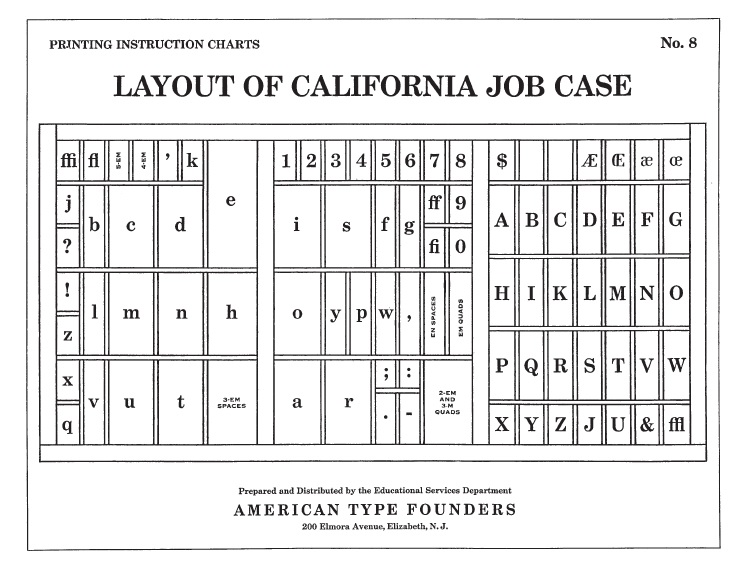
| HOME - > DIRECTORY -
> HAND TYPE COMPOSITION TYPE CASE LAYOUT CHARTS ~ USING SPACES AND QUADS ~ A PAGE ABOUT TYPE |
||
 |
Hand Type Composition for Letterpress Printing (really old school typesetting) |
 |
| Setting Foundry Type in a hand-held composing stick
should be the first thing
any new printer should master. After all, without type -
you will only be able to print from engravings, and that's
not really part of letterpress printing,
that's merely press work. So. It's time to begin documenting how I was taught to set hand type - and how I have been doing it since 1962... See the ATF Instruction Charts on this page. American Type Founders supplied an entire series of large charts to schools that could be posted on the walls in the shop as reminders of the accepted techniques - plus technical references on various type-related subjects. When I set type, my left thumb is always "in the stick" and aligns the letters as they are set. As I pick up a piece of type from the case, I rotate it between my thumb and forefinger to find the nick (by feel only - without looking at it), then set it into the stick and slide it tight against the last letter with my thumb. I only point this out because I have already seen other instances of folks in a position of authority doing it wrong - and, worse than that, *teaching* it incorrectly. They lack the "old school" trade training I realize that few folks these days have been part of the tradition of hand composition, but I actually had a job - in 1967 - when my entire job was "hand comp and makeup" hand-setting and distributing type and making up forms. And, of course, I began setting type when I was 12 and actually learned hand comp in the high school print shop. - and I also learned from the old masters - working comps in various print shops I visited or worked in over the years - and I feel an obligation to pass on what I learned then to a new generation now... Before the Linotype came into use around 1900, all type was set by hand and there were actual competitions where skilled hand comps would set 1,000 ems in an hour. I was never that fast, but I am pretty quick and that speed - and accuracy - is a direct result of following the procedures that I was taught by men far older than I was at the time... Set the line in the stick - rotating the piece of type between the right thumb and index finger, then set it into the stick - nick up - and push it into place - and hold it there with the left thumb. Set each line using 3-em spaces between words, then read the line to catch any typos, and then justify it in the stick so that it "stands" on its own and is *precisely* the same length as the line set before it. This will assure a nice, tight lockup with out using so much pressure that the chase is distorted or worse, yet. broken. And believe me, I have found many, many chases broken by the force of the quoins. In fact, I have broken a chase or two myself over the years. Cast iron is brittle and a quoin *can* apply enough force to break a cast iron chase... This page is a work in progress which will be updated as time allows... begun June 13, 2019 |
||
ATF Student "PRINTING INSTRUCTION CHART"
perhaps the most common and most popular
Could be see in just about any American High School Print Shop for many years

The Common 2/3 size type case is similar, however, in the2/3 case, caps are across two top rows.
[an image of the 2/3 case layout is coming]
How to Hold the Composing Stick

~~~~~~~~~~~~~~~~~~~~~~~~~~~~~~~~~~~~~~~~~~~~